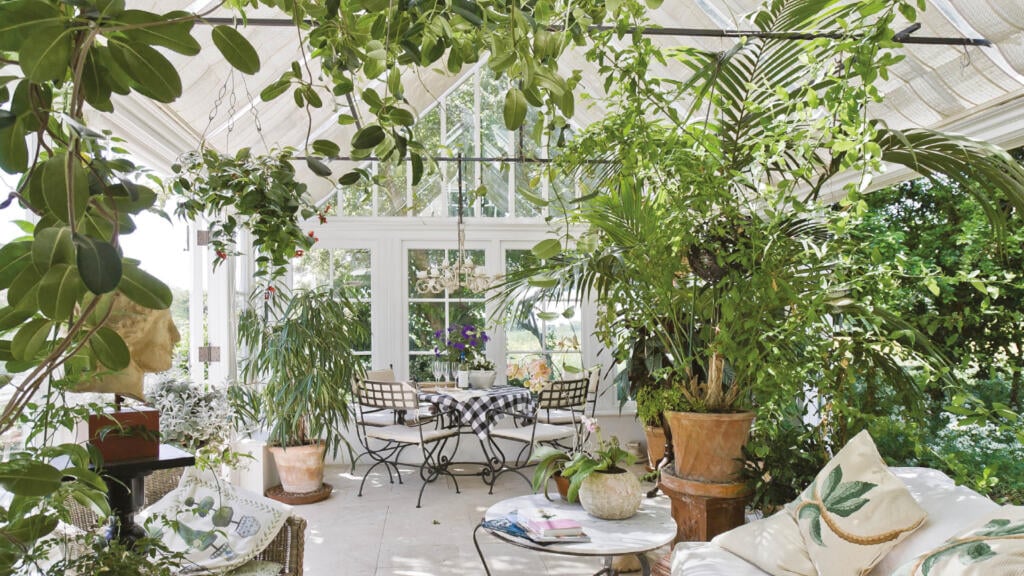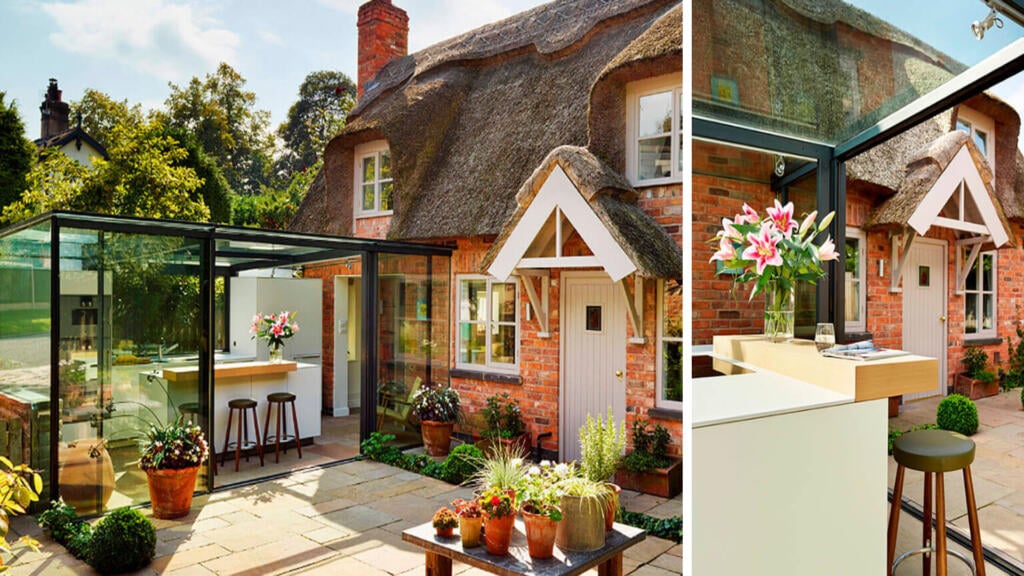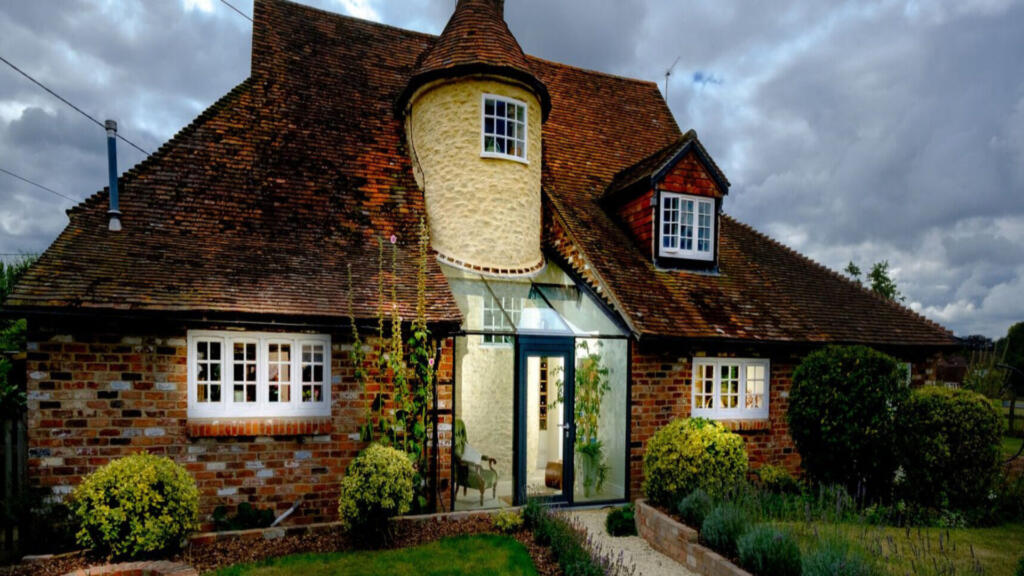
Get ready for summer with these sunny conservatory ideas
Sarah Harley
From generous Georgian builds to contemporary glass boxes, our guide to the different types of conservatory will help you choose the perfect look.
Whether you’re looking to add another living room, increase your kitchen space or simply add a year-round sunny spot, choosing the right style of conservatory can be a time-consuming task.
While most conservatory design is basically bespoke – there isn’t really a ‘one size fits all’ solution – knowing which style you prefer is essential to getting the result you desire.
Whether you’re looking to add another living room, increase your kitchen space or simply add a year-round sunny spot, choosing the right style of conservatory can be a time-consuming task.
While most conservatory design is basically bespoke – there isn’t really a ‘one size fits all’ solution – knowing which style you prefer is essential to getting the result you desire.
 Credit: Vale Garden Houses
Credit: Vale Garden HousesThat’s where we can help. We’ve rounded up a list of the different types of conservatory available so you can start thinking about which one is right for you.
 Credit: Vale Garden Houses
Credit: Vale Garden Houses“This is a simple and practical design built with a single sloping roof that leans against the existing building,” says Ash Lane, marketing expert at Vale Garden Houses. “It can be a popular choice for those with limited space or on a budget.”
Unlike other conservatories which have their own hipped or ridged roofline, a lean-to conservatory’s roof can be set at an angle to suit your home – meaning it’s also suitable for smaller homes and bungalows as it takes up less overall space.
As with any conservatory, the materials you choose for your structure are down to personal preference. There are fully glazed constructions, more standard uPCV designs, and you can also opt for a tiled or solid roof.
Lean-to conservatories are generally built as an additional room, accessed by a door from the main house, unlike other larger conservatory designs which can involve removing an external wall for a more open-plan approach.
PROS: Good when you’ve got limited space and you’re looking for a budget option.
CONS: A sloped glazed roof makes it hard to add ceiling lighting.
 Credit: Shutterstock/Monkey Business Images
Credit: Shutterstock/Monkey Business ImagesPredominantly constructed of glass with a timber, aluminium or uPCV frame, by definition, a conservatory is a structure where the roof contains at least 75% glass and the walls a minimum of 50%.
With a plethora of glass, a traditional conservatory gives ample opportunity for adding extra light to your home and although there are no other defining features, it is often used as a term to cover Victorian and Edwardian styles.
According to Lane, “a traditional conservatory also sometimes features Victorian or Edwardian decorative elements, such as finials and cresting.”
PROS: Vast amounts of light and extra living space for year-round enjoyment of your outdoor environment.
CONS: Can become too hot or too cold if not well ventilated or insulated.
Don’t assume that just because your conservatory features so much glass it’s exempt from local planning rules. It’s a common misconception. The amount of glass affects the level of building control needed, rather than whether or not you need planning permission. As with any addition to your home, your conservatory may need planning permission or permitted development rights at the very least.
 Credit: Hampton Conservatories
Credit: Hampton Conservatories“One of the most distinguishing features of a conservatory is the roof, composed entirely of glazed panels,” says Mervyn Montgomery, founder, and joint director, Hampton Conservatories .
“However, in some locations and situations, an entirely glazed roof is not suitable or preferable, so homeowners can opt for a solid-roof design instead.
This provides additional shade during the summer months and a cosier feel in the winter,” he says, while sharing a word of caution. “It’s still important to incorporate the correct ratio of glazing to create the desired bright and airy space below. This can be achieved by careful consideration of the aspect, use of glass in the walls, a clerestory and glazed gables.
In architectural terms, a clerestory is a section above the main windows containing additional, smaller windows located above eye level. Generally fixed and non-opening, they are a design detail and provide extra light.
PROS: Can help avoid over-heating during the summer months and heat escaping in the winter.
CONS: Could resemble an extension rather than a conservatory.
 Credit: Vale Garden Houses
Credit: Vale Garden Houses“Orangeries generally exhibit a formal and classical architectural style,” says Lane, “and are characterized by solid construction with brick or stone walls, large windows, and an inset glazed roof.”
They tend to be larger in size and have an elegant and grander feel than some conservatory types, with entablature detail around the roof and at least one roof lantern.
They are usually connected to the house open-plan, which allows light to flood through the orangery and into the space beyond.
“Orangeries serve as versatile living spaces,” says Lane, “suitable for various uses such as dining areas, kitchens, home offices, sitting rooms, or extensions to existing living spaces.”
PROS: Solid construction methods and an abundance of light provides ample opportunity for a variety of uses.
CONS: They’re more expensive due to the amount of work involved in creating the detailed roof design.
 Credit: James Price
Credit: James PriceAlthough traditional conservatory types – such as orangeries – can be adapted to embrace modern design, if you are looking for something a little more contemporary there are plenty of options available.
“With sleek lines and minimalistic features, contemporary conservatories offer a seamless indoor-outdoor transition,” says Lane.
Whether you opt for a frameless glass box, or a bespoke aluminium framed design, a contemporary conservatory can also act as a powerful architectural statement when added to a period property.
Regardless of their final design, a contemporary conservatory shares the same benefits as a traditional one – an immediate connection with the outdoors and protection from the often-inclement UK weather.
PROS: Designed to maximise exposure to light and the outdoors.
CONS: A lot of glass to clean and may not suit everyone’s taste – including local planners.
 Credit: David Salisbury
Credit: David SalisburyA gable conservatory is a “structure that can take many forms,” says Lane. But there is one feature that sets it apart. “Usually square or lean-to, it will feature a triangular frontage with a high, vaulted ceiling offering a spacious and airy environment.”
Even if you don’t have a lot of space, “a gable naturally provides a sense of height and grandeur,” according to Lane, making it a good option if you want to achieve the more formal look of a period style conservatory but have less space for your structure.
PROS: Can suit a property where external space is at a premium.
CONS: Adding a higher gable end that exceeds your existing roof line may prove an issue if you are looking to build under permitted development. rights
 Credit: Vale Garden Houses
Credit: Vale Garden HousesAs the name suggests, this conservatory type features a raised, central glazed lantern on top of a pitched or flat roof.
Adding an interesting design element and allowing more light to flood the space below, it’s also a feature you can add to an existing flat-roof conservatory should you find yourself hankering after more conservatory lighting.
PROS: The combination of glass and solid surface makes it easier to install ceiling lights.
CONS: The high location of the lantern could make it trickier to clean.
 Credit: Vale Garden Houses
Credit: Vale Garden HousesAccording to Lane, a Victorian conservatory is recognisable by its “ornate style which can take many forms but will generally incorporate intricate detailing copied from that of the Victorian period.”
Specific style features may include contain gothic detailing to the windows, a bay-fronted design and a steeply pitched roof with ornate edge rails.
PROS: Great if you’re a fan of detailed architectural design.
CONS: The ornate style is unlikely to suit modern homes.
 Credit: David Salisbury
Credit: David SalisburyFollowing the Victorian period, Edwardian design has a less ornate finish, but still carries a distinct formal style. Also, Edwardian conservatories are often square or rectangular in shape, which makes them feel less fussy and more modern than other period designs.
Typically featuring a flat front and a multi-hipped roof, Lane says: “Edwardian conservatories will be taller in structure than a Victorian conservatory. They will often have a clerestory but generally have more simpler detail.” This can include large panes of glass with smaller sections of glass either above or surrounding it, as show above. Edwardians were keen on stained-glass features, too, so this can be in keeping with this style of conservatory.
PROS: The lower-level pitched roof makes it a relatively straightforward addition to properties, such as bungalows, which don’t have a high roof line.
CONS: Unless you opt for a solid roof, you’ll need to consider ceiling blinds or solar-control glazing to avoid it overheating.
Although the Edwardian and Elizabethan era are similar in terms of conservatory design – both favouring pitched roofs, clean lines and an elegance to their design – Elizabethan conservatories are identified by having slightly less architectural flourishes than their Edwardian counterparts.
 Credit: Anglian
Credit: AnglianNamed for its resemblance to the letter P, this conservatory type combines a lean-to conservatory (the long part of the P) with a projecting bay at the end – often Edwardian or Victorian in style with a multi-faceted roof and window design giving this part a more rounded look.
PROS: The layout naturally creates two defined areas in the conservatory, which you could assign to different uses.
CONS: Better suited to larger period properties with space to accommodate the generous proportions of a P-shape design.

Written by Sarah Harley she/her
Published:
Since first picking up a paintbrush and experiencing the joy of re-decorating her bedroom in a questionable red, white and grey scheme as a young teenager, Sarah Harley was hooked on the world of interior design. This obsession even led to a real life ‘Grand Designs’ project in 2005 when she donned a pink hard hat and appeared on TV screens, project managing the renovation and extension of a Grade II listed 17th century Folly in South Wales.
Throughout her career, Sarah has gained an array of experience in several different roles, ranging from copywriting, PR, events management and photography to interior design and home staging. With her two passions being the written word and the joys of a beautifully designed home, Sarah’s mission is to open the door on the world of interiors, inviting readers in to help them work their way through the vast choice of products, ideas and trends so that their own homes can reach their full potential.

Sarah Harley

Sarah Harley

Camilla Sharman

Sarah Harley